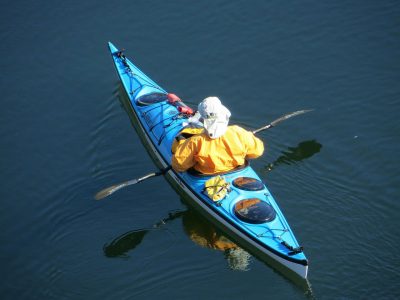
Image by Tom Watson
One big question potential kayak buyers ask is whether to get a single or double kayak for their recreational paddling. There are myriad websites extolling the virtues of each style, offering comparisons that include the weight of each type of boat, the freedom (or not) of paddling at your own pace and along your own chosen route. These and other considerations are important, but let’s look at the basic, practical aspects between a single kayak and a tandem boat.
First off, I am referring to actual sea kayaks, not squatty poly-molded rec’ kayaks, but full-size, ocean-touring boats. Those “tandem” plastic boats are often merely slightly extended singles with a second seat on a sit-on-top platform. For a more complete kayaking experience, the more serious paddler’s choices are a double/tandem with two distinct cockpits vs. a single cockpit kayak. Here are some critical aspects of each type:

Single Kayak
- Freedom to pursue your own course, from point A to B, or along your own route pass rookeries, or rock outcroppings, interesting shorelines, etc.;
- No conflicts with rudder use or maneuvering boat with paddle;
- Freedom to paddle at your own pace (and not required to synchronize with the other tandem paddler);
- Typically more storage space for gear per kayaker per boat, or by splitting stowing of gear between boats;
- Side-by-side conversations are easier than front-to-back in tandem;
- Lighter weight for transport, loading, etc.,
- Requires higher level of kayaking skills and capsize/recovery techniques (and a second solo paddler can aid/assist significantly in those processes);
- Disproportionately more expensive than a double cockpit boat;

Image courtesy of Adventure SUP & Kayak Tours
Double/Tandem Kayak
- Requires coordination of effort in course decisions;
- Stern paddler responsible for directional progress, steering, rudder control;
- Synchronized paddling cadence required in shorter-spaced tandem cockpit configurations; (tandems with a stowage hatch area between fore-aft cockpits usually provides enough room for kayakers to paddle out of synch’.);
- Typically more stable in rougher conditions;
- Paddlers can take turns resting to counter fatigue;
- Appreciably heavier and more unwieldy than a single boat;
- Limited space for gear, varies by models;
- Generally can be paddled faster than two single kayaks;
- Larger kayakers can often paddle a tandem in solo mode (trimming boat by using front cockpit for extra gear stowage).
The key to these particular aspects of singles and doubles is that they refer mostly to traditional touring kayaks, not quiet-water, recreational boats that are significantly shorter and often much wider than those traditional designs. The advantages of a recreational tandem boat over a single includes the capability to take another paddler — kids, non-kayakers, etc. — for a fun experience on the water.
A prudent way to check out any kayak, and particularly the feel for a tandem boat vs. a solo kayak, is to participate in an on-water demo day from a reputable dealer. You can get a feel for the boat’s handling and needs from the cockpit itself. Alternately, if a demo isn’t possible, sign up for a guided tour that uses doubles and singles as their main watercraft. You may find out in one afternoon which boat may fulfill — or exceed — your expectations.
Once the coordination between tandem paddlers is worked out, that shared kayaking experience soon overshadows any initial handling frustrations. For solo kayakers, heading out alone (presuming you have advanced skills) or embarking on a group paddle is no less personally satisfying.
Single or double: Be Safe; Be Smart; Have Fun!
Tom Watson is an award-winning outdoor safety and skills columnist and author of guide books on tent camping, hiking and self-reliant survival techniques. His website is www.TomOutdoors.com.
 Your Privacy Choices
Your Privacy Choices
 The
The